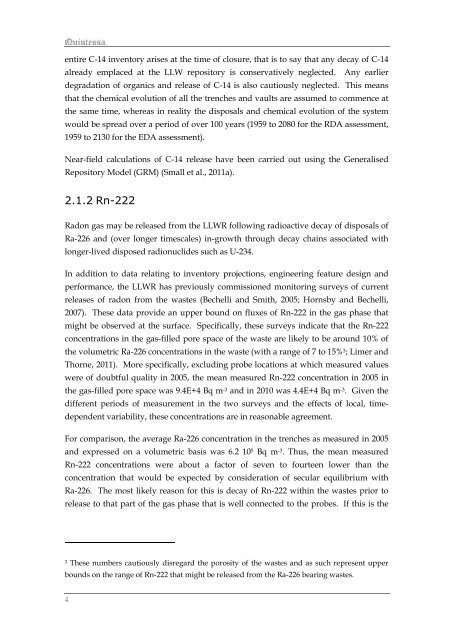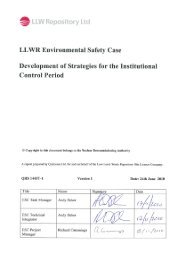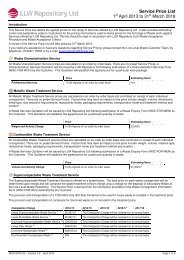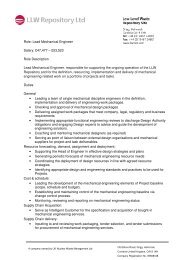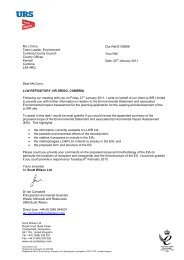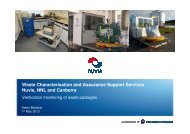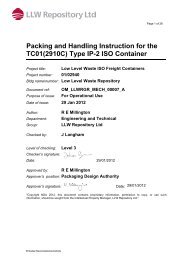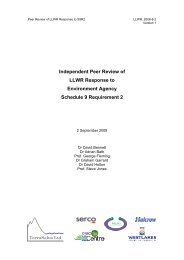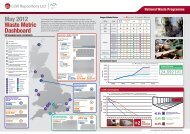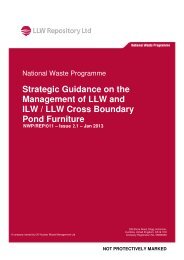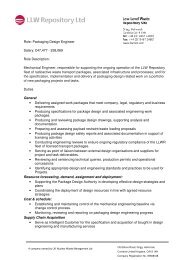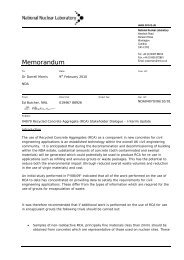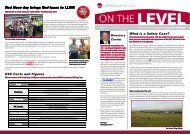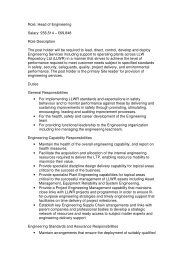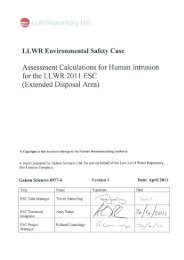Limer LMC, Assessment Calculations for C-14 Labelled Gas and ...
Limer LMC, Assessment Calculations for C-14 Labelled Gas and ...
Limer LMC, Assessment Calculations for C-14 Labelled Gas and ...
You also want an ePaper? Increase the reach of your titles
YUMPU automatically turns print PDFs into web optimized ePapers that Google loves.
entire C-<strong>14</strong> inventory arises at the time of closure, that is to say that any decay of C-<strong>14</strong>already emplaced at the LLW repository is conservatively neglected. Any earlierdegradation of organics <strong>and</strong> release of C-<strong>14</strong> is also cautiously neglected. This meansthat the chemical evolution of all the trenches <strong>and</strong> vaults are assumed to commence atthe same time, whereas in reality the disposals <strong>and</strong> chemical evolution of the systemwould be spread over a period of over 100 years (1959 to 2080 <strong>for</strong> the RDA assessment,1959 to 2130 <strong>for</strong> the EDA assessment).Near-field calculations of C-<strong>14</strong> release have been carried out using the GeneralisedRepository Model (GRM) (Small et al., 2011a).2.1.2 Rn-222Radon gas may be released from the LLWR following radioactive decay of disposals ofRa-226 <strong>and</strong> (over longer timescales) in-growth through decay chains associated withlonger-lived disposed radionuclides such as U-234.In addition to data relating to inventory projections, engineering feature design <strong>and</strong>per<strong>for</strong>mance, the LLWR has previously commissioned monitoring surveys of currentreleases of radon from the wastes (Bechelli <strong>and</strong> Smith, 2005; Hornsby <strong>and</strong> Bechelli,2007). These data provide an upper bound on fluxes of Rn-222 in the gas phase thatmight be observed at the surface. Specifically, these surveys indicate that the Rn-222concentrations in the gas-filled pore space of the waste are likely to be around 10% ofthe volumetric Ra-226 concentrations in the waste (with a range of 7 to 15% 3 ; <strong>Limer</strong> <strong>and</strong>Thorne, 2011). More specifically, excluding probe locations at which measured valueswere of doubtful quality in 2005, the mean measured Rn-222 concentration in 2005 inthe gas-filled pore space was 9.4E+4 Bq m -3 <strong>and</strong> in 2010 was 4.4E+4 Bq m -3 . Given thedifferent periods of measurement in the two surveys <strong>and</strong> the effects of local, timedependentvariability, these concentrations are in reasonable agreement.For comparison, the average Ra-226 concentration in the trenches as measured in 2005<strong>and</strong> expressed on a volumetric basis was 6.2 10 5 Bq m -3 . Thus, the mean measuredRn-222 concentrations were about a factor of seven to fourteen lower than theconcentration that would be expected by consideration of secular equilibrium withRa-226. The most likely reason <strong>for</strong> this is decay of Rn-222 within the wastes prior torelease to that part of the gas phase that is well connected to the probes. If this is the3 These numbers cautiously disregard the porosity of the wastes <strong>and</strong> as such represent upperbounds on the range of Rn-222 that might be released from the Ra-226 bearing wastes.4


